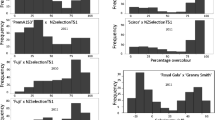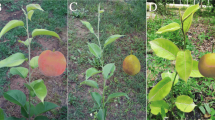Abstract
Presence, absence and intensity of red skin color in peach fruit are key characters for breeding varieties adapted to different market niches and consumer preferences. Red skin color is the result of anthocyanins, and in some progenies, the suppression of red skin color has been found to be controlled by a single gene, H/h, where plants homozygous for the recessive allele (h) produce the highlighter (anthocyaninless) phenotype. In this paper we analyzed an F2 population of 276 individuals segregating for this trait and mapped the H gene on a 5 cM region of linkage group 3. This region was saturated with additional markers and finally H was located in a genomic region of ~607 kbp containing 62 genes. Three of these genes corresponded to MYB10 transcription factors, known to control anthocyan biosynthetic pathways in peach and other species, such as cherry and apple. A codominant marker based on the sequence of one of these genes (PpMYB10.1) was used to genotype the F2 progeny and cosegregated with the trait. To further validate the marker it was tested in a collection of 87 peach cultivars. A strong association was found between the marker genotype and the intensity of red blush, with the three cultivars that have a complete absence of red blush being homozygous for the marker allele associated with the highlighter trait, confirming that it could be used as an efficient, although not diagnostic, marker to select this character in peach breeding programs.




Similar content being viewed by others
References
Aranzana MJ, Carbó J, Arús P (2003) Microsatellite variability in peach [Prunus persica (L.) Batsch.]: cultivar identification, marker mutation, pedigree inferences and population structure. Theor Appl Genet 106:1341–1352
Beckman TG, Sherman WB (2003) Probable qualitative inheritance of full red skin color in peach. HortScience 38:1184–1185
Beckman TG, Rodriguez Alcazar J, Sherman WB, Werner DJ (2005) Evidence for qualitative supression of red skin color in peach. HortScience 40(3):523–524
Brandi F, Bar E, Mourgues F, Horváth G, Turcsi E, Giuliano G, Liverani A, Tartarini S, Lewinsohn E, Rosati C (2011) Study of ‘Redhaven’ peach and its white-fleshed mutant suggests a key role of CCD4 carotenoid dioxygenase in carotenoid and norisoprenoid volatile metabolism. BMC Plant Biol 11:24
Cantín CM, Crisosto CH, Ogundiwin EA, Gradziel T, Torrents J, Moreno MA, Gogorcena Y (2010) Chilling injury susceptibility in an intra-specific peach [Prunus persica (L.) Batsch] progeny. Postharvest Biol Technol 58:79–87
Crisosto CH, Costa G (2008) Preharvest factors affecting peach quality. In: Layne DR, Bassi D (eds) The peach: botany production and uses. CAB International, Cambridge, pp 536–549
Dirlewanger E, Graziano E, Joobeur T, Garriga-Calderé F, Cosson P, Howad W, Arús P (2004) Comparative mapping and marker-assisted selection in Rosaceae fruit crops. Proc Natl Acad Sci USA 101:9891–9896
Donoso JM, Eduardo I, Picañol R, Batlle I, Howad W, Aranzana MJ, Arús P (2015) High-density mapping 493 suggests cytoplasmic male sterility with two restorer genes in almond × peach progenies. Hortic Res 2:15016
Donoso JM, Picañol R, Serra O, Howad W, Alegre S, Arús P, Eduardo I (2016) Exploring almond genetic variability useful for peach improvement: mapping major genes and QTLs in two inter-specific almond × peach populations. Mol Breed 36:16
Doyle JJ, Doyle JL (1990) Isolation of plant DNA from fresh tissue. Focus 12:13–15
Eduardo I, Pacheco I, Chietera G, Bassi D, Pozzi C, Vecchietti A, Rossini L (2011) QTL analysis of fruit quality traits in two peach intraspecific populations and importance of maturity date pleiotropic effect. Tree Genet Genomes 7:323–335
Eduardo I, López-Girona E, BatlIe I, Reig G, Iglesias I, Howad W, Arús P, Aranzana MJ (2014) Development of diagnostic markers for selection of the subacid trait in peach. Tree Genet Genomes 10:1695–1709
Eduardo I, Cantín CM, Batlle I, Arús P (2015a) Integración de los marcadores moleculares en un programa de mejora de variedades de melocotonero. Fruticultura 44:6–17
Eduardo I, Picañol R, Rojas E, Batlle I, Howad W, Aranzana MJ, Arús P (2015b) Mapping of a major gene for the slow ripening character in peach: co-location with the maturity date gene and development of a candidate gene-based diagnostic marker for its selection. Euphytica 205:627–636
Espley RV, Brendolise C, Chagné D, Kutty-Amma S, Green S, Volz R, Putterill J, Schouten HJ, Gardiner SE, Hellens RP, Allan AC (2009) Multiple repeats of a promoter segment causes transcription factor autoregulation in red apples. Plant Cell 21:168–183
Falchi R, Vendramin E, Zanon L, Scalabrin S, Cipriani G, Verde I, Vizzotto G, Morgante M (2013) Three distinct mutational mechanisms acting on a single gene underpin the origin of yellow flesh in peach. Plant J 76(2):175–187
Frett TJ, Reighard GL, Okie WR, Gasic K (2014) Mapping quantitative trait loci associated with blush in peach 510 [Prunus persica (L.) Batsch]. Tree Genet Genomes 10:367–381
Gradziel TM, Beres W, Pelletreau K (1993) Inbreeding in California canning clingstone peach cultivars. Fruit Var J 47:160–168
Iglesias I, Echeverría G (2009) Differential effect of cultivar and harvest date on nectarine color, quality and consumer acceptance. Sci Hortic 120:41–50
Iglesias I, Ruiz S (2016) Evolución de la producción y superficie de melocotón en España. Vida Rural 407:28–34
Illa E, Sargent DJ, Lopez Girona E, Bushakra J, Cestaro A, Crowhurst R, Pindo M, Cabrera A, van der Knaap E, Iezzoni A, Gardiner S, Velasco R, Arús P, Chagné D, Troggio M (2011) Comparative analysis of rosaceous genomes and the reconstruction of a putative ancestral genome for the family. BMC Evol Biol 11:9
Jung S, Cestaro A, Troggio M, Main D, Zheng P, Cho I, Folta KM, Sosinski B, Abbott A, Celton JM, Arús P, Shulaev V, Verde I, Morgante M, Rokhsar DR, Velasco R, Sargent DJ (2012) Whole genome comparisons of Fragaria, Prunus and Malus reveal different modes of evolution between Rosaceous subfamilies. BMC Genomics 13:129
Layne DR, Jiang ZW, Rushing JW (2001) Tree fruit reflective film improves red skin coloration and advances maturity in peach. Hortic Technol 11:234–242
Liverani A, Giovannini D, Brandi F (2002) Increasing fruit quality of peaches and nectarines: the main goals of ISF-FO (Italy). Acta Hortic 592:507–514
Nicotra A, Conte L, Moser L, Fantechi P (2002) New types of high quality peaches: flat peaches (P. persica var. Platicarpa) and Ghiaccio peach series with long on tree fruit life. Acta Hortic 592:131–135
Peace CP, Crisosto CH, Gradziel TM (2005) Endopolygalacturonase: a candidate gene for freestone and melting flesh in peach. Mol Breed 16:21–31
Picañol R, Eduardo I, Aranzana MJ, Howad W, Batlle I, Iglesias I, Alonso JM, Arús (2013) Combining linkage and association mapping to search for markers linked to the flat fruit character in peach. Euphytica 190:279–288
Quilot B, Wu BH, Kervella J, Génard M, Foulongne M, Moreau K (2004) QTL analysis of quality traits in an advanced backcross between Prunus persica cultivars and the wild relative species P. davidiana. Theor Appl Genet 109:884–897
Rahim MA, Busatto N, Trainotti L (2014) Regulation of anthocyanin biosynthesis in peach fruits. Planta 240:913–929
Reig G (2013) Selección de nuevas variedades de melocotón [Prunus persica (L.) Batsch] en función de caracteres agronómicos, morfológicos, de calidad y de conservación del fruto. PhD Dissertation, Universitat de Lleida
Reig G, Iglesias I, Gatius F, Alegre S (2013) Antioxidant capacity, quality, and anthocyanin and nutrient contents of several peach cultivars [Prunus persica (L.) Batsch] grown in Spain. J Agric Food Chem 61:6344–6357
Ru S, Main D, Evans K, Peace C (2015) Current applications, challenges, and perspectives of marker-assisted seedling selection in Rosaceae tree fruit breeding. Tree Genet Genomes 11(1):834
Scorza R, Sherman WB (1996) Peaches. In: Janick J, Moore JN (eds) Fruit breeding, vol I., Tree and tropical fruits Wiley, New York, pp 325–440
Sooriyapathirana SS, Khan A, Sebolt AM, Wang D, Bushakra JM, Lin-Wang K, Allan AC, Gardiner SE, Chagné D, Iezzoni AF (2010) QTL analysis and candidate gene mapping for skin and flesh color in sweet cherry fruit (Prunus avium L.). Tree Genet Genomes 6:821–832
Tuan PA, Bai S, Yaegaki H, Tamura T, Hihara S, Moriguchi T, Oda K (2015) The crucial role of PpMYB10.1 in anthocyanin accumulation in peach and relationships between its allelic type and skin color phenotype. BMC Plant Biol 15:280
Van Ooijen JW (2011) Multipoint maximum likelihood mapping in a full-sib family of an outbreeding species. Genet Res 93(5):343–349
Voorrips RE (2002) MapChart: software for the graphical presentation of linkage maps and QTLs. J Hered 93(1):77–78
Yamamoto T, Yamaguchi M, Hayashi T (2005) An integrated genetic linkage map of peach SSR, STS, AFLP and RAPD. J Jpn Soc Hortic Sci 74:204–213
Zhang Y, Butelli E, Martin C (2014) Engineering anthocyanin biosynthesis in plants. Curr Opin Plant Biol 19:81–90
Zhou Y, Zhou H, Lin-Wang K, Vilongmangkang S, Espley RV, Wang L, Allan AC, Han Y (2014) Transcriptome analysis and transient transformation suggest an ancient duplicated MYB transcription factor as a candidate gene for leaf red coloration in peach. BMC Plant Biol 14:388
Acknowledgements
We acknowledge financial support from the Spanish Ministry of Economy and Competitiveness, through the “Severo Ochoa Programme for Centres of Excellence in R&D” 2016–2019 (SEV‐2015‐0533) and Project AGL2012-40228, and from the CERCA Programme-Generalitat de Catalunya.
Author information
Authors and Affiliations
Corresponding author
Electronic supplementary material
Below is the link to the electronic supplementary material.
Rights and permissions
About this article
Cite this article
Bretó, M.P., Cantín, C.M., Iglesias, I. et al. Mapping a major gene for red skin color suppression (highlighter) in peach. Euphytica 213, 14 (2017). https://doi.org/10.1007/s10681-016-1812-1
Received:
Accepted:
Published:
DOI: https://doi.org/10.1007/s10681-016-1812-1




